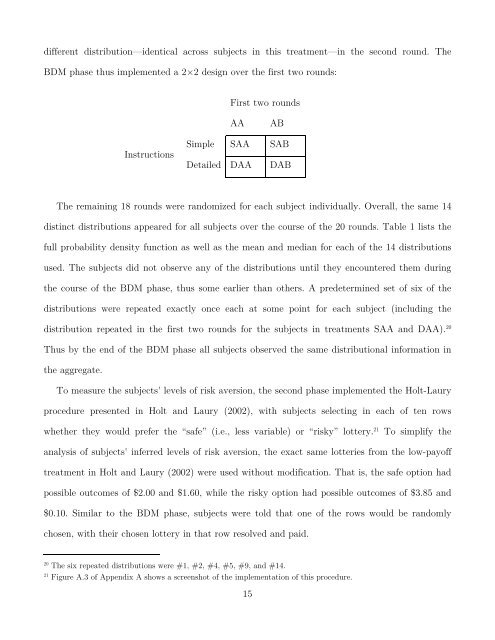Testing Distributional Dependence in the Becker-DeGroot-Marschak ...
Testing Distributional Dependence in the Becker-DeGroot-Marschak ...
Testing Distributional Dependence in the Becker-DeGroot-Marschak ...
Create successful ePaper yourself
Turn your PDF publications into a flip-book with our unique Google optimized e-Paper software.
different distribution—identical across subjects <strong>in</strong> this treatment—<strong>in</strong> <strong>the</strong> second round. The<br />
BDM phase thus implemented a 2×2 design over <strong>the</strong> first two rounds:<br />
Instructions<br />
First two rounds<br />
AA AB<br />
Simple SAA SAB<br />
Detailed DAA DAB<br />
The rema<strong>in</strong><strong>in</strong>g 18 rounds were randomized for each subject <strong>in</strong>dividually. Overall, <strong>the</strong> same 14<br />
dist<strong>in</strong>ct distributions appeared for all subjects over <strong>the</strong> course of <strong>the</strong> 20 rounds. Table 1 lists <strong>the</strong><br />
full probability density function as well as <strong>the</strong> mean and median for each of <strong>the</strong> 14 distributions<br />
used. The subjects did not observe any of <strong>the</strong> distributions until <strong>the</strong>y encountered <strong>the</strong>m dur<strong>in</strong>g<br />
<strong>the</strong> course of <strong>the</strong> BDM phase, thus some earlier than o<strong>the</strong>rs. A predeterm<strong>in</strong>ed set of six of <strong>the</strong><br />
distributions were repeated exactly once each at some po<strong>in</strong>t for each subject (<strong>in</strong>clud<strong>in</strong>g <strong>the</strong><br />
distribution repeated <strong>in</strong> <strong>the</strong> first two rounds for <strong>the</strong> subjects <strong>in</strong> treatments SAA and DAA). 20<br />
Thus by <strong>the</strong> end of <strong>the</strong> BDM phase all subjects observed <strong>the</strong> same distributional <strong>in</strong>formation <strong>in</strong><br />
<strong>the</strong> aggregate.<br />
To measure <strong>the</strong> subjects' levels of risk aversion, <strong>the</strong> second phase implemented <strong>the</strong> Holt-Laury<br />
procedure presented <strong>in</strong> Holt and Laury (2002), with subjects select<strong>in</strong>g <strong>in</strong> each of ten rows<br />
whe<strong>the</strong>r <strong>the</strong>y would prefer <strong>the</strong> “safe” (i.e., less variable) or “risky” lottery. 21 To simplify <strong>the</strong><br />
analysis of subjects' <strong>in</strong>ferred levels of risk aversion, <strong>the</strong> exact same lotteries from <strong>the</strong> low-payoff<br />
treatment <strong>in</strong> Holt and Laury (2002) were used without modification. That is, <strong>the</strong> safe option had<br />
possible outcomes of $2.00 and $1.60, while <strong>the</strong> risky option had possible outcomes of $3.85 and<br />
$0.10. Similar to <strong>the</strong> BDM phase, subjects were told that one of <strong>the</strong> rows would be randomly<br />
chosen, with <strong>the</strong>ir chosen lottery <strong>in</strong> that row resolved and paid.<br />
20 The six repeated distributions were #1, #2, #4, #5, #9, and #14.<br />
21 Figure A.3 of Appendix A shows a screenshot of <strong>the</strong> implementation of this procedure.<br />
15


